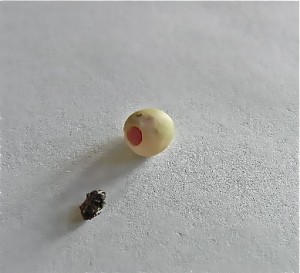
I’ve not started planting seeds this spring. What is stopping me? Everything. First of all we are still getting light frost some nights. Secondly, my youngest labradoodle, “Maddie” thinks my vegetable beds are her own private “digging grounds” and my low pressure plastic emitters her “chew toys”. So last night I put all excuses aside and dug out my seed collection, hoping to be inspired by the contents spread out over my kitchen island.
“What the……..?” I poured out my envelope of snow pea seeds (collected and saved from last summer) and there among the tan-colored legumes was a little weevil. “How did you get in there, and what kind of shenanigans have you been up to?”
A little research came up with the following information. My little weevil was cowpea beetle. Common to California, it is contracted in the field and spends its larval and pupal stage inside the pea, munching away at the tasty interior. It then emerges through a hole on the side of the pea. The cowpea weevil is considered a serious storage pest. “No s____!” Excuse my language but on further examination of my precious saved snow peas, I found many weevils and many empty seeds.

According to the UC Pest Management Guidelines, “Sanitation offers the most practical means of control. Because field infestations originate from beans, eliminate potential sources of weevils in production areas. Potential sources of weevils include broken sacks of seed beans left over from planting; seed beans left in planting hoppers; cull beans used in animal feed programs in a production area; small collections of beans remaining on or in a harvester following harvest; and small piles of beans remaining in or around the field after harvest or in a warehouse area.”
Not sure how I can apply this to my home garden but I’ll be careful to check in on my stored snow peas next year. If the problem continues, I’ll have to BUY my pea seeds next spring! God forbid!



Can you tell me some ideal things to plant for fall gardening in Carmel Valley? Thanks.
Hi Gail. Don’t know how I missed your comment. You’ve probably already planted your winter vegetables by now, but if not, here are some suggestions. Artichokes, fava beans, garlic, and peas grow vigorously through winter. Cabbage and lettuce can grow through winter, as well as broccoli and brussels sprouts if set out in the fall. Beet, carrots, kohlrabi and parsnips can be planted now, then will just sit during the winter months but give a nice spring crop. Oregano, parsley, rosemary, sage, thyme are among perennial herbs that grow slowly through the winter months. If you find some others that work well for you, please post. I’d love to hear about it.
I collected my mature snow peas at harvest. Plucked them from their pods and stored them in pickle jars with lids on snugly. I also found these little monsters had chowed down over the winter. Peas I had give to family and friends for planting had the same issue. I am picking fresh peas in May and am finding them. I have noticed the yellow jackets congregate on the pea vines. (predator insects)
I’m open to suggestions. I’m in Oregon.
Wish I had suggestions for you to deal with these little beetles that invade peas. I really didn’t know they were in fresh peas. The only solution I could find was to clean up really well around plants in the fall, and keep dried peas in airtight containers. Sounds like you’ve done that. The yellow jackets seem like another issue. What would attract them to pea plants? Do you have aphids that produce “honeydew”. The excrement of sucking insects, called “honeydew” may be attracting them but I can’t image they are attracted to the beetles. Wish I could help you!
I also have these little beetles in my (snow)pea seeds. (I have not seen them in fresh peas.) Last year I noticed just a few in my seeds when I pulled them out of winter storage. I culled through the seeds and thought I had destroyed all of the ones that looked suspect, and I got rid of the beetles that emerged. However, this year my pea seeds are almost entirely infested! Some have emerged already and in most of the other seeds I can see a tiny covering over the hole and can see the beetle that is hanging out inside. So I’m disposing of all the seeds as you suggest, and I too am going to have to buy fresh seeds next year. I’m also in (western) Oregon. Would not planting peas for a year help? Would the beetles then die out and/or move on to “better pastures”? I’m curious if the beetles will return next year, even if I buy new seeds…
You need to put your pea seed in the freezer for 24 hours immediately after they have been dried. Solved my beetle/weevil problem 100% with no additional issues. Peas germinated just fine next spring – note: I germinated my peas in a jar before planting to ensure proper sprouting – soak in water for about two hours, then pour the water off and place the jar on it’s side with the lid on. Then about three times a day add water for about 5 minutes, then pour off and place the jar on it’s side again. Be ready to plant! they will sprout in 2 to 4 days – you need to get them in the ground when the sprout “tail” in no longer than about one inch.
Thanks so much for this tip! Sprouting before planting really helps with germination in our dry climate!